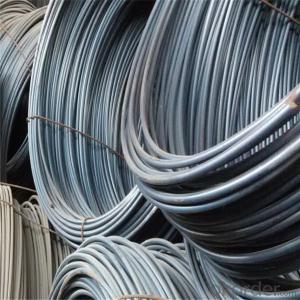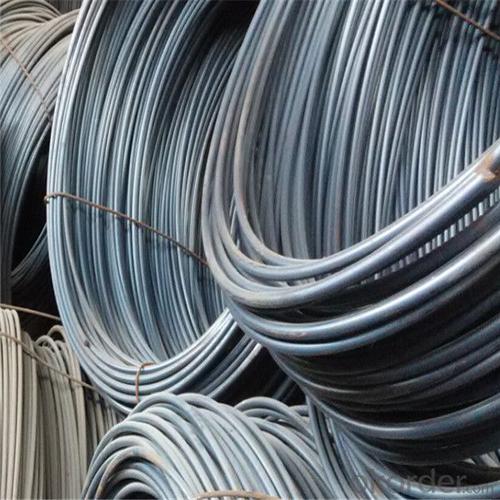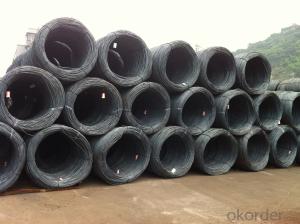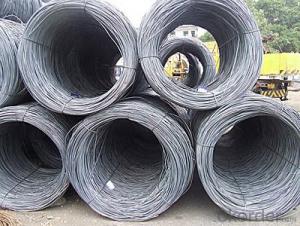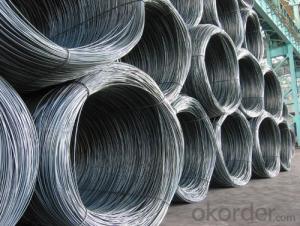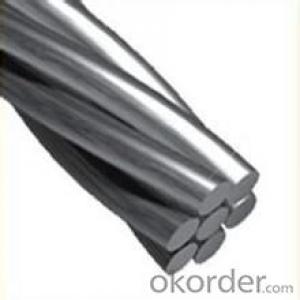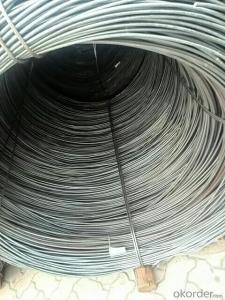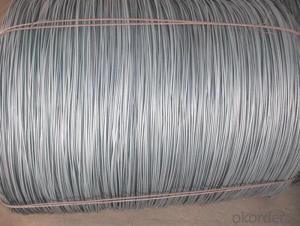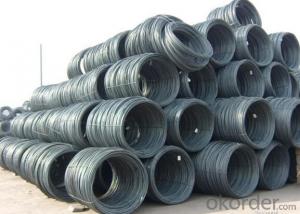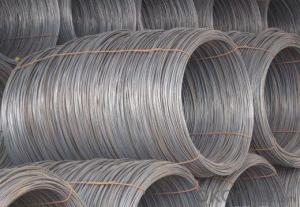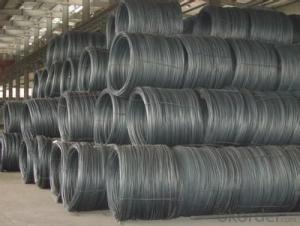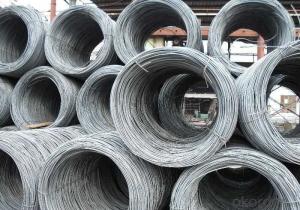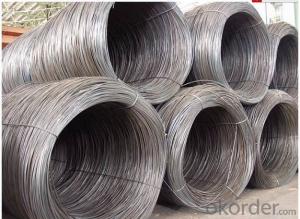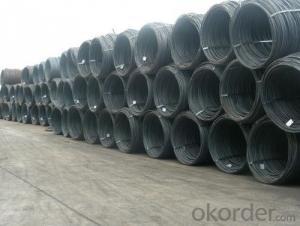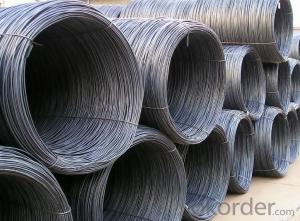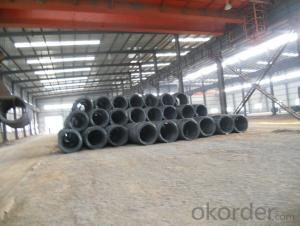Steel wire rod SAE1008B 5.5mm 6.5mm 10mm sae1008cr
- Loading Port:
- Shanghai
- Payment Terms:
- TT OR LC
- Min Order Qty:
- 100 m.t.
- Supply Capability:
- 17632 m.t./month
OKorder Service Pledge
OKorder Financial Service
You Might Also Like
Specification
Wire rod is used for many different products. Depending upon how it is cold formed and heat treated,
wire is used, for example, to produce not only wire ropes, barbed wire, wire mesh and nails, but also
springs, welded wire mesh and reinforcement wire.
Mainly used in building and construction as binding wire, tie wire and baling wire; also can be make for wire mesh.
Our Advantage: High quality steel products from 1 class mills in
Reasonable price
Professionalism of the products
On-time delivery
Complete documents and certificates
Sincere service to meet our clients' requirements
Product Description :
Standard | AISI, ASTM, BS, DIN, GB, JIS |
Material/steel grade | Q195-Q235,SAE1006B,SAE1006CR, SAE1008B, SAE1008CR, SAE1010B, SAE1018B, or according to customers requirements |
Wire Gauge | 5.5-12mm |
Coil weight | 1.8-2.1mts |
MOQ | 25MT |
Delivery Time | 15-30 days after receipt of L/C or deposit by T/T |
Packing | In coil and load in container, if large quantity, by bulk vessel; Can be packed as customers' special requirements |
Payment terms | 1).100% irrevocable L/C at sight. 2).30% T/T prepaid and the balance against the copy of B/L. 3).30% T/T prepaid and the balance against L/C |
Application | widely used in machinery parts, manufacturing industry, electronics industry, metal tools and others |
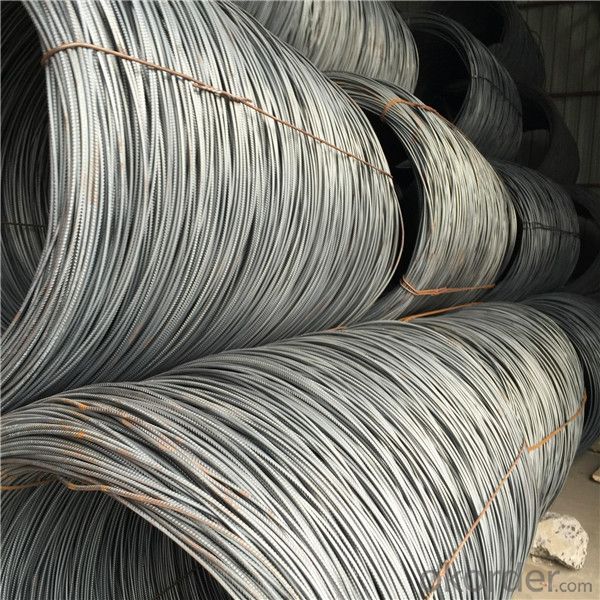
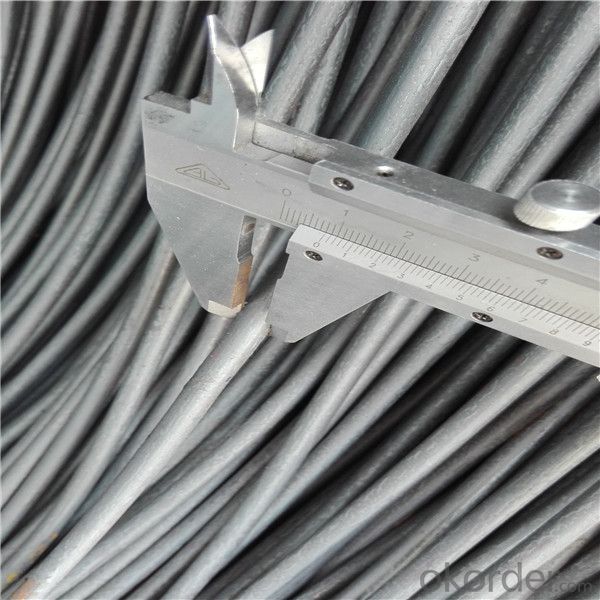
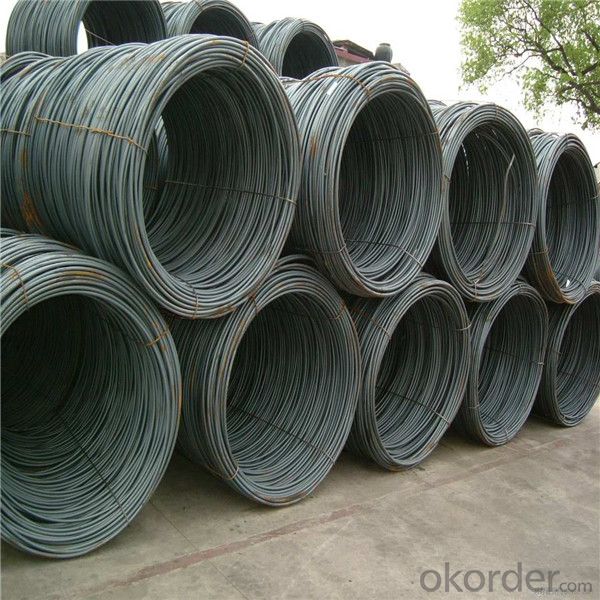
Application :
It generally used in braiding the hose for bathing product and machinery. With it
good flexibility, resistant to high temperature and resistant to corrosion, it
used widely in many industries.
Packing :
Hot-rolled wire rod is held in a unit with at least four steel straps in the
transverse direction and transported and stored without further packaging.
Before
the steel strapping is applied, the wire rod must be sufficiently compressed.
The strapping is fixed in the transverse direction with a single circumferential
strap so that the strapping does not slip and cause the coil to come apart.
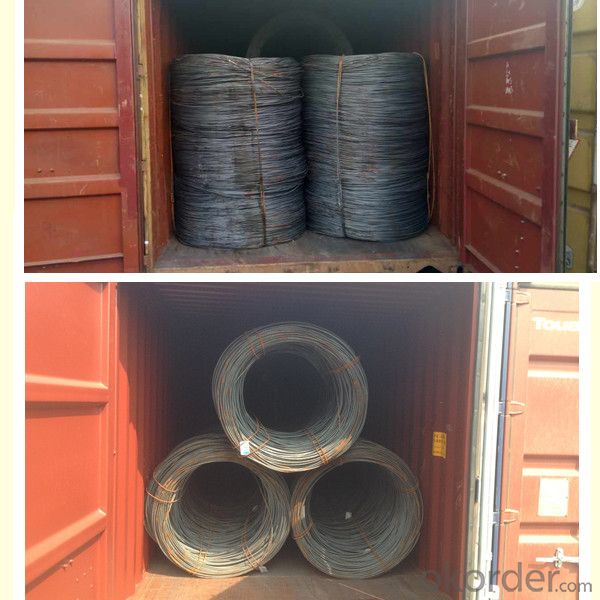
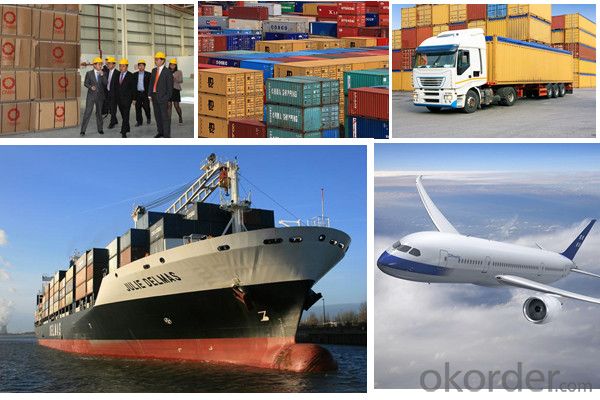
Our service:
(1) We cooperate with famous factories with advanced equipment and well trained workers.
(2) We can provide factory price with trading company service.
(3) We continuously work on the improvement of our processes, guaranteeing
consistently high standards of quality to keep none compensation.
(4) We guarantee 24 hours response and 48 hours solution providing service.
(5) We accept small order quantity before formal cooperation.
(6) We deliver the agreed quality at the agreed time, reacting to changes in
customer wishes in a flexible way.
(7) Due to our volume and selling power, we have excellent freight rates with
shipping lines.
(8) We strive to always be fair and honest in our dealings with customers.
(9) We strive to work together with customers to achieve much more than we can
achieve alone.
(10) Through our passion and commitment we aim to be a market leader in all our
key markets. To maintain our position as market leader we must continue to add
value in all that we do.
FAQ:
1.Q: What's your MOQ(minimum order quantity)?
A: One full container, mixed acceptable .
2. Q: What's your packing methods?
A: Packed in bundle or bulk ..
3. Q: How can I buy CNBM products in my country?
A:Please send us an inquiry or email ,we will reply to you if there is distributor in your country
4. Q: Can we visit your factory?
A: Warmly welcome. Once we have your schedule, we will arrange the
professional sales team to follow up your case.
5. Q: How long does it take to get the product if i place an order?
A:With the process of your requirements,we will pack and deliver in 3
-7 days. If it is by sea shipment,it will take 15-45 days depending on different locations
- Q: How does the tensile strength of steel wire rod vary with different wire drawing processes?
- The tensile strength of steel wire rod can vary significantly depending on the specific wire drawing process used. Wire drawing is a metalworking process that involves reducing the diameter of a wire by pulling it through a series of dies. Different wire drawing processes, such as cold drawing, hot drawing, and intermediate drawing, can have different effects on the tensile strength of the steel wire rod. During cold drawing, the steel wire rod is pulled through a die at room temperature. This process can increase the tensile strength of the wire rod significantly. Cold drawing aligns the metal's crystalline structure, which results in increased strength and hardness of the wire. The wire is also likely to have a smooth and uniform surface finish due to the cold drawing process. Hot drawing, on the other hand, involves pulling the steel wire rod through a die at elevated temperatures. This process can also increase the tensile strength of the wire rod, but to a lesser extent compared to cold drawing. Hot drawing allows for greater plastic deformation of the steel, resulting in improved ductility and reduced brittleness. The wire produced through hot drawing may have a rougher surface finish due to the higher temperatures involved. Intermediate drawing is a combination of both cold and hot drawing processes. In this process, the steel wire rod is initially subjected to hot drawing and then cold drawing. This combination allows for greater control over the mechanical properties of the wire, including tensile strength. Intermediate drawing can result in a wire with improved strength and ductility, as the hot drawing process improves plastic deformation and the cold drawing process aligns the crystalline structure. In summary, the tensile strength of steel wire rod can vary with different wire drawing processes. Cold drawing generally results in the highest increase in tensile strength due to the alignment of the crystalline structure. Hot drawing and intermediate drawing processes also increase strength but to a lesser extent, while providing other benefits such as improved ductility and reduced brittleness. The specific wire drawing process chosen depends on the desired mechanical properties and surface finish of the wire.
- Q: How is steel wire rod processed for subsequent applications?
- Steel wire rod is processed for subsequent applications through a series of steps. First, it undergoes descaling to remove any rust or impurities on the surface. Then, it is subjected to hot rolling, where the rod is compressed between rollers to reduce its diameter and increase its length. After hot rolling, the rod is cooled and then treated with heat to improve its mechanical properties. Finally, it is either coiled or cut into desired lengths, depending on the intended application.
- Q: What are the different welding techniques used for steel wire rod?
- There are several welding techniques commonly used for steel wire rod, including arc welding, resistance welding, and laser welding. Arc welding involves using an electric arc to heat and melt the wire rod, creating a strong bond. Resistance welding uses electrical current and pressure to join the wire rod, while laser welding utilizes a concentrated beam of light to melt and fuse the metal together. Each technique has its advantages and is suitable for different applications and requirements in the steel wire rod industry.
- Q: How is steel wire rod used in the manufacturing of wire forms for lighting fixtures?
- Steel wire rod is an essential component in the manufacturing of wire forms for lighting fixtures. The wire rod is primarily used as the raw material for creating various wire forms such as hooks, frames, and brackets that are integral to the structure and functionality of lighting fixtures. To begin with, the steel wire rod is first processed through a series of manufacturing steps. This typically involves the wire rod being drawn through a series of dies to reduce its diameter and increase its length. This process is known as wire drawing and results in a wire that is smooth, uniform, and of the desired thickness. Once the wire has been drawn, it is then further processed to create the specific wire forms required for lighting fixtures. This may involve bending, shaping, and cutting the wire to the desired dimensions. Various tools and equipment, such as wire forming machines and presses, are utilized to achieve the desired shapes and sizes. The wire forms created from the steel wire rod are then incorporated into the production of lighting fixtures. For instance, hooks made from the wire forms are used to suspend the fixtures from the ceiling or wall mountings. Frames made from the wire forms provide structural support and hold the components of the lighting fixture in place. Brackets made from the wire forms are used to attach the fixture to the wall or ceiling. Additionally, the wire forms made from steel wire rod are often used to create decorative elements in lighting fixtures. These can include intricate designs and patterns that enhance the aesthetics of the fixture. The wire forms can be shaped into various curves, loops, and spirals to create visually appealing and unique lighting designs. Overall, steel wire rod is an essential material in the manufacturing of wire forms for lighting fixtures. It provides the necessary strength, durability, and versatility required for creating functional and visually appealing lighting fixtures.
- Q: How is steel wire rod used in the production of wire ropes for mining applications?
- Steel wire rod is used as the primary raw material in the production of wire ropes for mining applications. It serves as the foundation for creating the wire strands that make up the rope. The wire rod is first cleaned and coated to enhance its durability and resistance to corrosion. It is then drawn through a series of dies to reduce its diameter and increase its strength. These drawn wires are then twisted or braided together to form the wire strands, which are further assembled into wire ropes used in mining operations. The high strength and resilience of steel wire rod make it a crucial component in ensuring the safety and reliability of wire ropes used in demanding mining conditions.
- Q: How is steel wire rod used in the manufacturing of wire for electrical cables?
- Steel wire rod is a crucial raw material used in the manufacturing of wire for electrical cables. It serves as the base material from which the wire is drawn and formed. The steel wire rod is subjected to a series of processes, including drawing, annealing, and coating, to transform it into a wire with the desired electrical conductivity and strength. This wire is then further processed and insulated to create electrical cables that are widely used in various applications, such as power transmission, telecommunications, and wiring installations.
- Q: How is steel wire rod used in the manufacturing of barbed wire?
- Steel wire rod is a crucial component in the manufacturing of barbed wire as it serves as the base material for creating the barbs. The steel wire rod is first drawn into thin wires, which are then twisted and shaped into sharp points or barbs. These barbs are then attached to a central wire, forming the characteristic barbed wire structure. This process ensures that barbed wire is strong, durable, and effective for various applications such as security fencing, livestock containment, and military purposes.
- Q: What are the different types of steel wire rod surface cleaning methods for wire galvanizing?
- There are several different types of steel wire rod surface cleaning methods that can be used for wire galvanizing. These methods are designed to remove any impurities or contaminants from the surface of the wire rod before it undergoes the galvanizing process. One common method is acid pickling. Acid pickling involves immersing the wire rod in a bath of acid solution, usually hydrochloric acid or sulfuric acid. The acid helps to dissolve any mill scale, rust, or other surface contaminants, leaving the wire rod clean and ready for galvanizing. Another method is mechanical descaling. This method involves using mechanical means, such as abrasive brushes or shot blasting, to physically remove any surface impurities from the wire rod. This method is often used for wire rods that have heavy scale or stubborn contaminants that cannot be easily removed by acid pickling alone. Additionally, there is a method called electrolytic cleaning. This method uses an electric current to remove surface impurities from the wire rod. The wire rod is immersed in an electrolyte solution, and an electric current is passed through the solution, causing the impurities to migrate away from the wire rod and towards the opposite electrode. This method is often used for wire rods that have a thin layer of oxide or other surface contaminants. Finally, there is a method called mechanical cleaning. This method involves using mechanical means, such as wire brushing or sanding, to physically scrub the surface of the wire rod and remove any surface impurities. This method is often used for wire rods that have light scale or surface contaminants that can be easily removed by mechanical means. Overall, the choice of cleaning method will depend on the specific requirements and condition of the wire rod. Each method has its own advantages and disadvantages in terms of effectiveness, cost, and environmental impact.
- Q: What are the different types of heat treatments used for steel wire rod?
- There are several types of heat treatments used for steel wire rods, each with its own purpose and benefits. Some of the most commonly used heat treatments include: 1. Annealing: This process involves heating the steel wire rod to a specific temperature and then slowly cooling it to improve its ductility and reduce internal stresses. Annealing also helps to refine the microstructure of the steel, making it easier to work with and enhancing its mechanical properties. 2. Quenching and tempering: Quenching is the rapid cooling of the steel wire rod after heating it to a high temperature. This process results in a hardened steel with increased strength and hardness. Tempering is then performed by reheating the quenched steel to a lower temperature to reduce brittleness and improve toughness while maintaining some of the hardness achieved during quenching. 3. Normalizing: Similar to annealing, normalizing involves heating the steel wire rod to a specific temperature and then allowing it to cool in still air. This process helps to refine the grain structure of the steel, improve its strength and toughness, and eliminate any internal stresses. 4. Stress relieving: This heat treatment is performed to reduce residual stresses that may have accumulated in the steel wire rod during previous manufacturing processes. By heating the rod to a specific temperature and then cooling it slowly, stress relieving helps to prevent distortion or cracking of the material. 5. Case hardening: Also known as carburizing, this heat treatment involves introducing carbon into the surface layer of the steel wire rod to increase its hardness and wear resistance. The rod is heated in the presence of a carbon-rich atmosphere and then quenched to achieve the desired hardness. Overall, the choice of heat treatment for steel wire rods depends on the desired properties and applications of the final product. Each treatment method has its own advantages and is selected based on the specific requirements of the wire rod.
- Q: What are the factors that affect the strength of steel wire rod?
- Several factors can have an impact on the strength of steel wire rods. To begin with, the composition of the steel plays a significant role. The presence of specific elements, such as carbon, manganese, and silicon, can enhance the strength of the wire rod. Generally, a higher carbon content results in greater strength. Furthermore, the strength is also influenced by the manufacturing process and the level of heat treatment. Proper heat treatment, like quenching and tempering, tends to increase the strength of the wire rod compared to inadequate heat treatment. The cooling rate during quenching and the subsequent tempering temperature can significantly affect the final strength. Moreover, the diameter or thickness of the wire rod affects its strength. Thinner rods typically have higher tensile strength as they allow for greater strength per unit of area due to their smaller cross-sectional area. In addition, the presence of impurities and defects in the steel can weaken the wire rod. Inclusions, such as non-metallic particles, can act as stress concentrators and reduce the strength. Similarly, defects like cracks or voids can serve as initiation points for failure under stress. Finally, external factors, such as the environment and the level of stress, can also impact the strength of the wire rod. Exposure to corrosive substances or high temperatures can degrade the wire rod, leading to reduced strength. Additionally, the level of stress applied during manufacturing or in its application can affect its strength and durability. To sum up, the strength of steel wire rods is influenced by factors such as the composition of the steel, the manufacturing process, heat treatment, diameter, presence of impurities and defects, as well as external conditions and stress levels.
Send your message to us
Steel wire rod SAE1008B 5.5mm 6.5mm 10mm sae1008cr
- Loading Port:
- Shanghai
- Payment Terms:
- TT OR LC
- Min Order Qty:
- 100 m.t.
- Supply Capability:
- 17632 m.t./month
OKorder Service Pledge
OKorder Financial Service
Similar products
Hot products
Hot Searches
Related keywords
